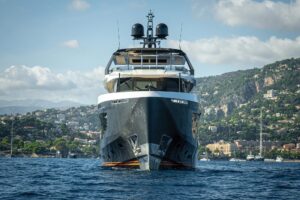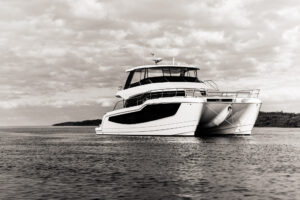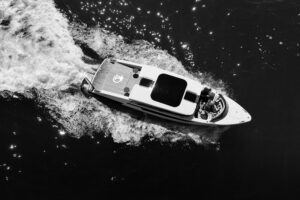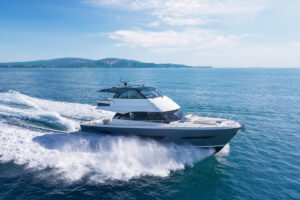A few years ago while I was touring the Viking Yachts factory in New Gretna, New Jersey with Vikings’ director of communications Peter Frederiksen, he was chuckling about how they were trying to get a bow pulpit on board the company plane to take to a Nantucket rendezvous. Apparently Viking Yachts President Bill Healey was on his way to the annual event and hearing that an owner had damaged their boat while docking, wanted to make sure his wound was mended before the event kicked off. Having spent a fair amount of time with the folks at Viking, I can honestly say that this type of service underscores the company’s service philosophy.
So when Viking decided to expand its operations to include motoryachts and express cruisers by forming Viking Sport Cruisers, it intertwined this same go-the-extra-mile ethos into the new company. The carry-over was assured by tapping 20-year Viking veteran Tom Carroll as president and CEO.
Carroll, his son Tom Jr., and Frederiksen walked me through the new Viking 57 Sport Cruisers Flybridge Yacht before we headed out for speed trials. It was evident that Carroll Sr. is a perfectionist who understands how he wants these boats set up. Our guided tour went into pause mode on several occasions while Carroll questioned an execution of a detail or design feature. It was obvious he was enthusiastically following another Healey mantra I heard from Viking staff on several occasions: make each boat better than the last.
It helps that Sport Cruisers are well-thought-out quality builds to begin with. I’ve run a 65, 84, and now the 57 and have always walked away impressed with naval architect Bernard Olesinski’s hull design. Each was dry and comfortable. The 57 benefits from a conventional hard-chine planing hull and a moderately deep 19-degree transom deadrise. The propeller pockets reduce draft to a very manageable 4 feet, 2 inches.
Although other engine options are in the works, the 715 hp Volvos appeared to be well suited for the 57, propelling her to a top speed just over 30 knots and an honest cruising speed of around 25 knots. “They’re not into power as much as we are”, Frederiksen said referring to the British builder and buyers. But a 57-foot motoryacht with “moderate power achieving these comfortable speeds is noteworthy.”
The quiet ride from the lower station is also a pleasing attribute. Sitting at this station, my line of sight to all corners was excellent; while banking the boat hard over, I could easily see the traffic around us and found no blind spots. At top speed we recorded a measly 74 dB(A) sound level. This is impressive considering that the typical sound level for normal conversation is 65 dB(A). While seated at the helm I could carry on an easy conversation with Carroll, who was parked on the portside U-shape settee. A companion seat flanks the helm seat.
The engineroom allows enough space to get around the diesels for routine service. If major service is required, the saloon sole lifts above the engines and a soft patch is incorporated into the flying bridge deck allowing for easy removal. Engineroom access is from the lazarette. On this 57, unlike some of her European siblings, the lazarette area was left unfinished and not built as crew quarters. This results in a huge area with more than enough room for fenders and stores, allowing serious down-island cruising. Unless you really need a crew stateroom, I would go for the lazarette.
Another sensible application is the 57’s tender system. A 770-pound capacity crane recesses into the transom and the tender is stowed on the platform. The platform, however, is part of the hull and the waterline extends to the end. As a result, if you are caught in a following sea you don’t have to worry about seas lifting the tender underneath, a symptom of some hydraulic swim platform applications. I also like keeping the weight of the tender low versus stowing it on the bridge.
Carroll and crew apply this same level of thinking to the interior appointments. “Everything is designed to serve a purpose on these boats”, Carroll said during our walkthrough, pointing to the stools that stow under the forward berth serving both the vanity and upper dinette. The laundry area, for example, is tucked under the saloon sole and accessed from the galley sole. This area also includes an upright Whirlpool freezer along with a washer and dryer. Keeping the freezer, an appliance that is not accessed on a regular basis, below the sole frees up the galley for more stowage. All appliances are U.S. specs following the Viking credo of serviceability.
This philosophy also translates into machinery accessibility in the interior. “You can remove the a/c air filter in one to two minutes”, said Carroll, revealing an access panel. Wiring is tagged and accessible, and sub-panels and pumps are easily serviced.
The one thing I could not figure out is which stateroom would be the master-the amidships or forward stateroom. The forward stateroom technically qualifies as a guest stateroom since it shares the head with the portside guest cabin, but other than that it deserves the presence of an owner. An overhead hatch and ports bring in streams of light, while the centerline berth has plenty of access on each side. Abaft this stateroom is the “master with an en suite head and two large ports that create a very open, bright feel.
The fit and finish of the high-gloss cherry interior combined with the leather settees should please even the fussiest owners. The finish is on par with a lot of higher priced custom yachts I’ve been on board.
These luxury appointments are complemented by smart cruising touches like high bulwarks, tall railings, plenty of grab rails and tough deck hardware. A Lewmar windlass is flanked by two bow lockers and an anchor washdown, allowing the 57 to break free from the dock and spend some precious time on the hook.
After we returned to the dock, Carroll explained a little more of the relationship between Viking Sport Cruisers and the British builder Marine Projects, highlighting the flow of ideas and cross-pollination of technology. “It works well for both of us”, he said. After my latest Viking Sport Cruisers experience I might add that this combination should also work well for anyone looking for a motoryacht with European flair and American roots.
Contact: Viking Sport Cruisers, Inc. (609) 296-6000; www.vikingsportcruisers.com. For more information, contact: (866) 922-4877; www.yachtingnet.com/yachting/productinfo.
Michael Verdon is frequent contributor to Yachting and a former editor of Motor Boating magazine.









